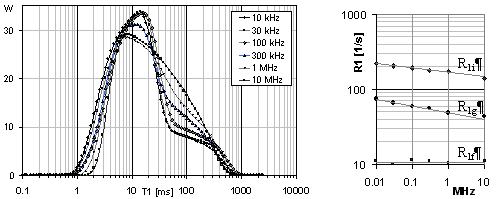Abstract
1H-NMR relaxation times of water-saturated rock samples are widely employed to characterize the architecture of pore space and to estimate petrophysical properties, such as permeability and irreducible water saturation. These parameters are used both in laboratory studies and in well logging (NML).
So far, such NMR studies were always carried out at a fixed frequency (typically 10 or 20 MHz in laboratory and 2 MHz in NML). It is well known [1] that NMR relaxation rates are inherently field dependent, a fact which might represent a complicating factor in the above mentioned applications. Mono-exponential analysis of longitudinal relaxation curves so far published [2] indicate that the field dependence does exist, but is quite modest. However, it has been amply shown [3] that the mono-exponential hypothesis is rarely applicable to natural rocks, where one usually observes wide distributions of relaxation rates, due to the wide distributions of pore sizes and their physical and chemical properties.
For this reason, we have investigated the relaxation rate distributions in several carbonates and sandstones at a number of relaxation field values, ranging from 10 kHz to 30 MHz.

Cylindrical rock samples (8 mm in diameter and 11 mm in height) were saturated by water under vacuum. Their relaxation curves were measured on a Fast Field Cycling NMR Relaxometer produced by Stelar Srl. Pre-polarized (PP/S) and non-polarized (NP/S) acquisition sequences have been used with the following parameters: polarization field of 25 MHz (1H Larmor frequency), polarization time of 2.5 s, 128 logarithmically distributed t values (times in the relaxation field) ranging from 0.1 ms up to 4 s. Continuous distribution analysis of the curves was performed by UPEN [3].
The results are exemplified by the data obtained for the Pietra Serena sample shown in Fig.1. It is evident that:
(a) Geometric (R1g) and arithmetic means (R1i) of longitudinal relaxation rates indeed depend on field intensity (B) but the dependence is very weak. In the shown case, for example dlog<Rg>/dlog(B) = -0.07. In general, all the measured relaxation profiles, when plotted on a log-log scale, were approximately linear and their slopes did not exceed -0.1.
(b) No dependence on the field values can be detected for the longest relaxation rates R1f, obtained by mono-exponential fits of the tailing portions of the relaxation curves. It therefore appears that (i) different components of the sample exhibit different field dependencies and (ii) such dependencies tend to be steeper for the components with high relaxation rates (short T1's) and virtually null for components with low relaxation rates (long T1's).
(c) Despite the weak field dependence of the global relaxation parameters, there are significant and systematic field-dependent variation in the continuous distribution curves obtained by UPEN.
In view of what has been said in point (b), the field dependence of the distribution curves was to be expected. The extent of the variations, however, exceeds intuitive expectations and is subject to further study. We believe that, in principle, analysis of a set of T1 distribution curves obtained at a number of relaxation field values can allow one to better separate different sample components and associate a distinct field-dependence profile with each of them. Work aimed at achieving this goal is at present in progress.
[1] N. Bloembergen, E.M. Purcell, R.V Pound, Phys. Rev. 73, 679 (1948).
[2] S. Godefroy, J-P. Korb, M. Fleury, R.G. Bryant, Phys. Rev. E, 64, 21605 (2001).
[3] G.C. Borgia, R.J.S Brown, P. Fantazzini, J. Magn. Reson. 132, 65 (1998); ibidem 147, 273 (2000).
|